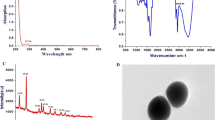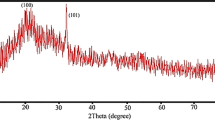Abstract
Green synthesis of selenium nanoparticles (SeNPs) was achieved by a simple biological procedure using the reducing power of fenugreek seed extract. This method is capable of producing SeNPs in a size range of about 50–150 nm, under ambient conditions. The synthesized nanoparticles can be separated easily from the aqueous sols by a high-speed centrifuge. These selenium nanoparticles were characterized by UV–Vis spectroscopy, scanning electron microscopy (SEM), Fourier transform infrared spectroscopy (FTIR), X-ray diffraction (XRD), and elemental analysis by X-ray fluorescence spectrometer (XRF). Nanocrystalline SeNPs were obtained without post-annealing treatment. FTIR spectrum confirms the presence of various functional groups in the plant extract, which may possibly influence the reduction process and stabilization of nanoparticles. The cytotoxicity of SeNPs was assayed against human breast-cancer cells (MCF-7). It was found that SeNPs are able to inhibit the cell growth by dose-dependent manner. In addition, combination of SeNPs and doxorubicin shows better anticancer effect than individual treatments.







Similar content being viewed by others
References
El-Sayed MA (2001) Some interesting properties of metals confined in time and nanometer space of different shapes. Acc Chem Res 34:257–264
McConnell WP, Novak JP, Brousseau LC, Fuierer RR, Tenent RC, Feldheim DL (2000) Electronic and optical properties of chemically modified metal nanoparticles and molecularly bridged nanoparticle arrays. J Phys Chem B 104:8925–8930
Liu C, Zhang ZJ (2001) Size-dependent superparamagnetic properties of Mn spinel ferrite nanoparticles synthesized from reverse micelles. J Chem Mater 13:2092–2096
Moreno-Mañas M, Pleixats R (2003) Formation of carbon–carbon bonds under catalysis by transition-metal nanoparticles. Acc Chem Res 36:638–643
Lanone S, Boczkowski J (2006) Biomedical applications and potential health risks of nanomaterials: molecular mechanisms. Curr Mol Med 6:651–663
Garnett MC, Kallinteri P (2006) Nanomedicines and nanotoxicology: some physiological principles. Occup Med 56:307–311
Sauvaire Y, Baissac Y, Leconte O, Petit P, Ribes G (1996) Steroid saponins from fenugreek and some of their biological properties. Adv Exp Med Biol 405:37–46
Drake EN (2006) Cancer chemoprevention: selenium as a pro-oxidant not an antioxidant. Med Hypotheses 67:318–322
Manna L, Scher EC, Alivisatos AP (2000) Synthesis of soluble and processable rod-, arrow-, teardrop-, and tetrapod-shaped CdSe nanocrystals. J Am Chem Soc 122:12700–12706
Poborchii VV, Kolobov AV, Tanaka K (1999) Photomelting of selenium at low temperature. Appl Phys Lett 74:215–217
Wang G, Yang X, Qian F, Zhang JZ, Li Y (2010) Double-sided CdS and CdSe quantum dot co-sensitized ZnO nanowire arrays for photoelectrochemical hydrogen generation. Nano Lett 10:1088–1092
Leonard KA, Hall JP, Nelen MI, Davies SR, Gollnick SO, Camacho S, Oseroff AR, Gibson SL, Hilf R, Detty MR (2000) A selenopyrylium photosensitizer for photodynamic therapy related in structure to the antitumor agent AA1 with potent in vivo activity and no long-term skin photosensitization. J Med Chem 43:4488–4498
Parnham MJ, Graf E (1991) Pharmacology of synthetic organic selenium compounds. Prog Drug Res 36:4–9
Sies H, Masumoto H (1997) Ebselen as a glutathione peroxidase mimic and as a scavenger of peroxynitrite. Adv Pharmacol 38:229–246
Zhang JS, Gao XY, Zhang LD, Bao YP (2001) Biological effects of a nano red elemental selenium. BioFactors 15:27–38
Wang H, Zhang J, Yu H (2007) Elemental selenium at nano size possesses lower toxicity without compromising the fundamental effect on selenoenzymes: comparison with selenomethionine in mice. Free Radic Biol Med 42:1524–1533
Tan L, Jia X, Jiang X, Zhang Y, Tang H, Yao S, Xie Q (2009) In vitro study on the individual and synergistic cytotoxicity of adriamycin and selenium nanoparticles against Bel7402 cells with a quartz crystal microbalance. Biosens Bioelectron 24:2268–2272
Chowdhury S, Ahmed H, Chatterjee BP (1987) Purification and characterization of an α-d-galactosyl-binding lectin from Artocarpus lakoocha seeds. Carbohydr Res 159:137–148
Singh J, Gupta K, Arora SK (2002) Changes in the anti-nutritional factors of developing seeds and pod walls of fenugreek (Trigonella foenum graecum L.). Plant Foods Hum Nutr 46:77–84
Huang H, Yuan Q, Yang X (2004) Preparation and characterization of metal-chitosan nanocomposites. Colloids Surf B 39:31–37
Christensen MJ, Nartey ET, Hada AL, Legg RL, Barzee BR (2007) High selenium reduces NF-κB-regulated gene expression in uninduced human prostate cancer cells. Nutr Cancer 58:197–204
Huang G, Zhang Y, Zhang Q, Zhang B, Wen L (2010) Vacuolization and apoptosis induced by nano-selenium in HeLa cell line. Sci China Chem 53:2272–2278
Acknowledgments
The authors acknowledge the Department of Science and Technology (DST), Government of India, New Delhi, India for the financial support in the form DST-FIST. The authors thank Central Instrumentation Facility, Pondicherry University. C. H. Ram expresses his special thanks to CSIR, India for the financial assistance in the form of CSIR, SRF, (Acknowledgement No:09/559/(0084)/2012 EMR-I).
Author information
Authors and Affiliations
Corresponding author
Electronic supplementary material
Below is the link to the electronic supplementary material.
Rights and permissions
About this article
Cite this article
Ramamurthy, C., Sampath, K.S., Arunkumar, P. et al. Green synthesis and characterization of selenium nanoparticles and its augmented cytotoxicity with doxorubicin on cancer cells. Bioprocess Biosyst Eng 36, 1131–1139 (2013). https://doi.org/10.1007/s00449-012-0867-1
Received:
Accepted:
Published:
Issue Date:
DOI: https://doi.org/10.1007/s00449-012-0867-1




